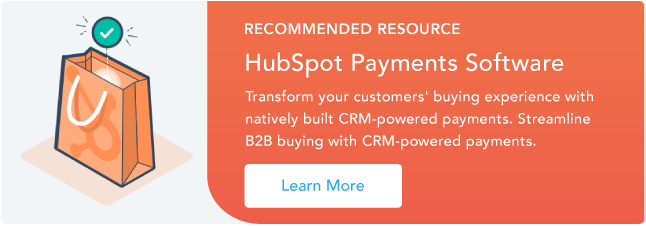How Does Subscription Management Work?
1. Set up your subscription management tools.
The first step is to set up the subscription management software according to your business needs. This means entering your product or service details, pricing models, billing cycles, and other relevant information.
2. Enable customer data management.
Import or input customer data into the software. This can include customer contact information, subscription details, and billing preferences. Or, if your subscription software integrates with a tool, like your CRM, set up that integration so the right data can flow and be managed between these tools.
3. Create and manage your subscriptions.
Using the subscription management software, create new subscriptions for customers, specifying the pricing plan, duration, and any add-ons or upgrades.
A subscription software should allow you to easily manage and modify subscriptions throughout their lifecycle, including upgrades, downgrades, renewals, or cancellations.
4. Send bills and invoices.
The subscription management software should automate the billing process, generating invoices based on the subscription terms and sending them to customers. The software should also offer flexible billing options, such as one-time or recurring payments, and integrate with popular payment gateways to securely process customer payments.
5. Use analytics features to report on KPIs.
Leverage the reporting and analytics capabilities of the software to gain insights into your subscription business and the ROI it’s generating.
Monitor important metrics such as churn rate, revenue, customer retention, and engagement trends. Then, use these insights to make data-driven decisions, refine your subscription offerings, and maximize revenue generation.
Why Manage Subscriptions?
Improved Revenue Predictability
Subscription management provides businesses with a predictable and recurring revenue stream. By effectively managing subscriptions, businesses can better forecast and predict their revenue, allowing for more accurate financial planning and growth projections.
Increased Customer Retention
Subscription management enables businesses to actively engage and retain customers. By monitoring usage patterns, sending timely renewal reminders, and offering personalized offers, businesses can increase customer satisfaction, reduce churn, and foster long-term loyalty.
Enhanced Customer Experience
Effective subscription management ensures a seamless customer experience throughout the entire lifecycle. Businesses can provide self-service options, manage billing efficiently, offer flexible upgrade or downgrade options, and address customer concerns in a timely manner, all of which contribute to a positive and satisfying customer journey.
Streamlined Operations
By automating billing processes, managing subscription changes, and integrating with other business systems, subscription management software streamlines operations. This results in increased efficiency, reduced manual errors, and saves time and resources that can be allocated to other critical aspects of the business.
Data-Driven Decision Making
Subscription management platforms provide valuable insights and analytics into customer behavior, subscription trends, and revenue metrics. By analyzing this data, businesses can make data-driven decisions, refine pricing strategies, identify upselling or cross-selling opportunities, and continuously improve their subscription offerings to meet customer needs.
Subscription Billing Models
Flat-Rate Subscription Billing Model
The flat-rate subscription billing model involves charging customers a fixed fee on a regular basis, regardless of their usage or consumption. It is a simple and straightforward pricing structure that offers customers unlimited access to a product or service.
Netflix offers a flat-rate subscription model where customers pay a fixed monthly fee to access their streaming platform and enjoy unlimited content.
Tiered Subscription Billing Model
The tiered subscription billing model involves offering different pricing tiers or plans with varying levels of features, benefits, or usage limits. Customers can choose the tier that best suits their needs and budget.
HubSpot offers a tiered subscription model for Sales Hub, with options ranging from free to paid plans at different levels. Each tier unlocks additional features and services, allowing customers to choose the plan that aligns with their requirements.
Per Unit or User Subscription Billing Model
In this model, customers are charged based on the number of units they purchase or the number of users they add to their subscription. The more units or users, the higher the cost.
Slack employs a per user subscription billing model, where organizations pay a fixed amount per user to access its collaboration and messaging platform. The more users added, the more the organization is billed.
Usage-Based Subscription Billing Model
The usage-based subscription billing model involves customers being charged based on their actual usage or consumption of a product or service. The billing is often determined by factors such as the amount of data used, the number of transactions completed, or time spent utilizing the service.
Amazon Web Services (AWS) uses a usage-based subscription billing model for its cloud computing services. Customers pay according to the resources they use, such as the volume of data stored, computing power consumed, and network bandwidth used.
Subscription Management Software: Key Features to Look For
Automated Billing
Automate billing with HubSpot Payments
If your customers pay for your offerings monthly, quarterly, or annually, the last thing you want to do is chase them down for payments. That's why a must-have feature for subscription billing software is the ability to automate the billing process.
Automated billing features, such as HubSpot's, help businesses in generating invoices, sending them to customers, and processing payments automatically, which saves time, reduces human error, and ensures seamless billing operations.
Flexible Pricing and Plans
Look for software that allows you to create and manage a variety of pricing models and plans. This flexibility enables you to offer different subscription tiers, customizable options, and promotional pricing to cater to the unique needs of your customers. The ability to easily modify and update pricing structures as your business evolves is also crucial.
Subscription Lifecycle Management
Effective subscription billing software should provide comprehensive lifecycle management capabilities. This includes managing subscriber sign-ups, upgrades, downgrades, renewals, and cancellations.
It should also offer automated notifications for subscription expirations, provide seamless options for plan changes and upgrades, and make it easy to handle cancellations and refunds.
Analytics and Reporting
Robust reporting and analytics features are essential for gaining insights into your subscription business. Look for software that provides comprehensive dashboards, customizable reports, and key metrics such as revenue, churn rate, and customer retention. This allows you to make data-driven decisions, identify trends, and optimize your subscription strategies.
Integration with Payment and Accounting Tools
HubSpot Payments integrates with finance software
Seamless integration with popular payment tools is important to ensure secure and efficient payment processing. Like HubSpot Payments, the software should support multiple payment methods, securely store customer payment information, and offer built-in PCI compliance. This integration ensures a smooth checkout experience for your customers while maintaining the highest level of security.
Dunning Management
Dunning management features help you handle failed payments and minimize customer churn. For example, the software should have an automated process for retrying failed payments, sending notifications to customers about payment issues, and offering easy payment options. This ensures you can retain customers (and revenue) by resolving payment issues promptly and effectively.
Customer Portal and Self-Service Options
A customer portal allows subscribers to manage their subscriptions, view billing history, update payment information, and access relevant support resources. This self-service functionality reduces the burden on your customer support team and empowers customers to have control over their subscriptions.
Additionally, a self-service portal creates a seamless and convenient experience for your customers, improving their satisfaction and reducing support tickets.
Get Started With Subscription Management
Now that you know the benefits of subscription management tools and the necessary features to look for, check out this post that walks through how to price your subscriptions, or sign up for HubSpot Payments and launch your subscription today.



